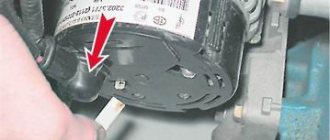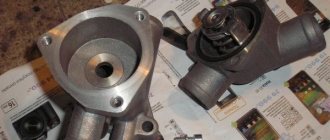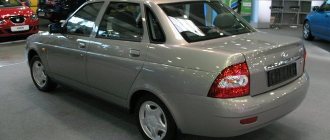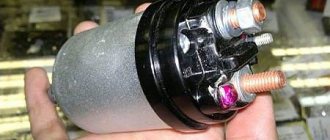VAZ 2110 is a Russian front-wheel drive sedan. In common language - “ten”, which is what the model means. Serial production of the Lada 2110 began in 1996. Initially, the passenger car was produced only as a sedan. Later, the auto giant expanded its lineup with the VAZ 2112 hatchbacks and VAZ 2111 station wagons, as well as the VAZ-21123 coupe.
The 110 model was first demonstrated to then Russian President Boris Yeltsin during a visit to the Volzhsky Automobile Plant in 1992. But the economic crisis prevented the car from quickly being put into mass production.
The appearance of the new model led to many innovations noticed by domestic drivers. For them, the “ten” has become almost a foreign car. Production of the “ten” ended in 2007, and it was replaced by a new model – Lada Priora. The entire Lada model range.
VAZ 21103 and other “ten” brethren: technical characteristics
In 1996, AvtoVAZ developed and introduced the new 2110 sedan. It is also known as the Lada 110, or “ten”.
This is the first post-Soviet car that looks like a foreign car. Like all new production cars, the “ten” was not without various modifications. One of them is 21103, released in 1997. It is often compared with the modification of the VAZ 21104. After all, the VAZ 21104 and 21103 are almost identical, despite the fact that the 21104 began to be produced only in 2004. The main common feature: the presence of a 16-valve injection engine. Let's look at the technical characteristics, parameters and distinctive features of the VAZ 21103 from other modifications of the VAZ 2110. Let's find out what the advantages and disadvantages of a larger number of valves in the cylinders are. VAZ 21103 and 21104 are no longer produced today, but despite this, the description of the characteristics will be useful for those wishing to purchase a car or current owners.
VAZ 21103 - the same top ten, but better
At the turn of the 20th-21st centuries, the plant in Tolyatti produced passenger cars, which later received the common name “Lada 110”. The next after this family is considered to be the “Priora”, which received many parts from the “ten” and its own, deeply modernized units with different capabilities and sores. As with earlier or later cars, VAZ did not limit itself to one version. The tenth had modifications, one of which was the VAZ 21103. We will look at the technical characteristics of this car a little later.
This car did not have climate control, an on-board computer and other things included in the basic equipment of a modern car. Nevertheless, it was the first car that looked like a foreign car. The plant still uses this body today, but current machines no longer have digital indices.
Model 21103 - “new” line 110
The VAZ 211103 model is the third modification of the 110 line. The oldest “brother” of this model is the first version of the Lada 2110 with an 8-valve carburetor engine, launched into production in 1996. Then, in the same 1996, the country saw the second modification of the VAZ 21102, which was designed to introduce injection engines into the line. But the number of valves still remained 8. And in 1997, the VAZ 21103 car with a sixteen-valve injection power unit was released.
In addition to the engine, version 21103 has the following innovations compared to its predecessors:
- ABS system;
- air conditioner;
- power steering.
Galvanized body, ventilated brakes, new gasoline vapor recovery system and air-conditioned interior. All these opportunities are real know-how for the Russian automotive industry in 1997. Additional trim levels also included power windows, metallic paint, 14-inch alloy wheels, and even an on-board computer.
Comparison of injection units
The VAZ 21103 operating manual indicates the following engine characteristics.
| Aspects | Options |
| Volume | 1.5 l |
| Maximum power | 94 l. With. (achieved when the crankshaft reaches 5600 rpm.) |
| Limit torque | 130 Nm (possible at 3600 rpm) |
| Number of cylinders | 4 (in-line arrangement) |
| Number of valves | 16 |
| Fuel supply system | Injection |
| Gasoline injection | Distributed |
| Compression ratio | 9,8 |
| Cylinder diameter | 82 mm |
| Piston stroke | 71 mm |
The VAZ 21104 operating manual prescribes parameters slightly different from the above. The engine volume is 100 ml larger and is 1.6 liters. Peak power is 98 hp. With. and is possible already at 5000 rpm. Torque is increased by 1 Nm, but to achieve it, the rotation speed must be increased by 100 rpm. more. The piston stroke has been increased by 4.6 mm, and accordingly the compression ratio has become 0.5 more.
Both the Lada 1103 model and the 1104 version are equipped with 16-valve injection engines.
Pros and cons of a 16-valve engine
The basic version and the first modification 21002 were equipped with 8-valve engines, that is, each cylinder had 2 holes (intake and exhaust). These units were equipped with a single camshaft driven by a belt or chain. This ensures simplicity of design. Therefore, for the first Lada 110 models, repairs by yourself are much easier. If there is a repair manual, you don’t have to resort to the help of service station workers.
The 8-valve design does not have automatic hydraulic compensators. This allows you to use cheaper gasoline and oil. In the 16-valve injection engine of the VAZ 21103, repairs are ensured in a short time if you fill in inappropriate fuels and lubricants. After all, foreign impurities in a short period of time can form carbon deposits on hydraulic compensators, which will render them inoperable. True, manual adjustment of the thermal clearances of an 8-valve engine takes time. In addition, such an engine can make unnecessary noise.
The advantages of the 8V engine include the small dimensions of the intake system; these elements do not block access to attachments. But in the case of VAZ 21103 and VAZ 21104, repairing the generator or starter is difficult due to the dimensional parts of the intake system. This fact has been repeatedly confirmed by service station specialists who often repair components and assemblies of the VAZ 2110.
But the most important advantage of the 16-valve engine, which outweighs the disadvantages, is dynamics. The total cross-section of 4 holes is in any case greater than the cross-section of 2 valves in one cylinder. Therefore, the fuel-air mixture in an eight-valve engine is injected more slowly, and more time is spent releasing exhaust gases. The dynamics of the car directly depend on these two phases of engine operation. After all, the slower gasoline enters the cylinders, the longer the VAZ engine takes to gain momentum. The larger intake system provides less noise and vibration for a more enjoyable ride.
In addition, hydraulic compensators, although dimensional, regulate thermal clearances automatically. The VAZ 21104 user manual does not have a separate section on manually adjusting thermal clearances. Because such a procedure with 16 valves is very complicated. If you make a mistake, you can throw off the optimal gap settings and complicate your repair. The 16V engine consumes less fuel. This is due to the greater throughput of the valves and the quick start of the engine into optimal operating mode.
If you are faced with the choice of buying a VAZ 8V or 16V, you need to clearly know in what conditions the car will be used. If dynamic driving is not a priority or there are no service stations nearby, an 8-valve engine is definitely better. After all, if there is an instruction or repair manual, you can fix it yourself.
For those who want dynamics and have the opportunity to be serviced at a service station, the 16-valve VAZ 21103 or VAZ 21104 engine is suitable.
Source
How much does a replacement cost?
To replace hydraulic compressors, you should take a whole set, since changing them one by one simply does not make sense. The price of a set of hydraulic compressors for a 16-valve VAZ-2112 model costs around 2000 rubles. And in order not to purchase defective spare parts, we suggest you watch the video:
The price for carrying out work to replace hydraulic compressors in a car service center will fluctuate around 3,000 rubles, but such work can be done with your own hands, you just need to strictly follow our detailed instructions.
Step-by-step process for replacing hydraulic compressors on a VAZ-2112
The work itself is not difficult, but it will require some attention and little effort, as it involves dismantling the valve cover and camshafts.
We carry out the work on a cold engine in the following order:
- The car is fixed on a flat surface, the hand brake is put on, and wheel chocks can be placed under the wheels.
- Disconnects the negative terminal from the battery.
- Remove the engine cover by unscrewing the four bolts.
- Then remove the receiver. Please note that after this, all inlet openings must be covered with a clean rag to prevent dirt and other foreign objects from entering.
- We remove the ignition module, which is held on by three bolts. It will be useful to visually check it for damage, since this is a disease of this node.
- Next, loosen the clamps and move the crankcase ventilation hose to the side.
- Remove the injector power supply clamp.
- The next step is to remove the valve cover of the “head”; to do this, you need to unscrew 15 bolts located around the perimeter.
- When it is dismantled, we see a general view of two camshafts and all its components.
- If you want to check which specific hydraulic compensator is faulty, just press on it. If pressing occurs with significant force, it is in good condition, and when it gives in easily, it must be replaced.
- To proceed to the next step, you need to remove the timing belt; how to do this is written in great detail in this article. Also read the material on how to properly tension the timing belt.
- When the belt is removed, unscrew the bolts and remove the camshaft drive gears and the crankshaft pulley.
- Remove the terminal from the oil pressure sensor.
- Carefully unscrew the 20 bolts that secure the housing above the camshafts.
- Then we remove the nut that secures the shaft support bracket on the rear side of the engine.
- We remove the entire body to the side.
- Now that access to the camshafts is open, we remove and put them away, not forgetting to set them again according to the marks.
- Now we can start replacing the hydraulic compressors, and here we will need a good magnet.
- Using a magnet, we take out all the old elements and put new ones in their place.
- We carry out the assembly process in the same order as removal, not forgetting to change the gaskets and apply sealant where necessary, paying attention to the joints and connections.
- We set the marks and put on the timing belt.
- We remove the remains of the dried sealant, connect all the devices, and at this point the work on replacing the hydraulic compressors can be considered complete.
We carry out diagnostics
After all repair work is completed, it is necessary to check the operation of the engine.
- If after starting you hear an extraneous sound, similar to cracking or clicking, this will mean that there is air in the operating area of the hydraulic compressors and it must be expelled, filling the entire space with oil.
- We carry out this work as follows: For 3-5 minutes we raise and maintain constant speed to 2500 rpm, after that we let it idle for another 1 minute, then we turn off the engine.
- After a short break, we start the engine again and listen to its operation. When sounds appear again, we do this pumping again. As a rule, oil is guaranteed to fill all cavities after 3 pumping attempts.
About LADA 2110 engines 1st generation (1995 - present)
The VAZ 2110 (Lada 110), popularly called the ten, is a front-wheel drive sedan, in the design of which the components and assemblies of the VAZ 2108 were used. With the VAZ 2110, a new, tenth VAZ family began. In particular, the family is represented by the VAZ 2111 station wagon and the VAZ 2112 hatchback. Until 2007, the VAZ 2110 was produced at AvtoVAZ production facilities, then production was transferred to other factories, where the car was assembled until 2014.
Compared to its predecessors, the VAZ 2110 has a more modern appearance and design, and has greater comfort. In this article we will look at the engines installed on the VAZ 2110, their characteristics and the most common faults.
Engine 21114, which has a second index of 11183, is a development of the ideas laid down by the 2111 1.5 liter power unit. and directly, 083 motor. The engine has a taller cylinder block, increased piston stroke, and a volume of 1.6 liters. The engine has improved environmental performance and greater reliability. Compared to VAZ 2111 engines, the VAZ 11183 unit is less capricious, more elastic and high-torque. If we compare these two engines, it should be noted that although they are assembled at the same plant, they are assembled on different lines.
Car history
In addition to the fact that the body of the Lada of the tenth family had smooth lines and was not at all similar to the body of the already boring “99th” model, the 110th model was able to introduce an abundance of new elements that had not previously been seen on vehicles produced by the Volzhsky Automobile Plant. Among the innovations are the presence of an adjustable steering wheel, glued windows, gas hood supports and air conditioning.
After they began installing a sixteen-valve power unit on the VAZ-2110, it became clear to everyone that “it’s better not to joke with Tazami,” since the car could even leave some foreign cars behind. The “Ten” was produced with three versions of equipment: standard, norm and luxury. Despite the stoppage of production of the VAZ-2110 in the Russian Federation, the model is still produced in Ukraine today as the Bogdan 2110.
Work on the design of the dozen began back in 1983. The very first car of this class was supposed to be a sedan with a rear-wheel drive layout. But the developments were never able to reach their own finish line. A little later, the company decided to start developing a vehicle on the VAZ-2108 platform.
However, the cost of this machine was exorbitant, so the developers decided to freeze this project as well. Over time, all the developments resulted in the VAZ-21099 car. At the first time of production, the car came with a carburetor power system, and after 2000 they decided to install distributor fuel injection (injector).
A little history
The VAZ “ten” line dates back to the 2110 sedan (1995). Three years later, the assembly of the 2111 station wagon model was established, and a year later the production of hatchbacks began. At first, the 2110 model was equipped with a sixteen-valve one and a half liter engine. These were the maximum capabilities of the famous automobile plant in those days.
But time passes and progress, including automotive progress, does not stand still - another car appears, VAZ-2112, 16 valve. The hitherto known eight-valve version had less dynamism and power. And the appearance of the car has become more sporty.
Additionally, we recommend reading the article by our specialist, which describes in detail the technical characteristics of the VAZ-2110.
Driver reviews
Most drivers who have ever owned or continue to use a VAZ-2110 to this day say that the car is inexpensive to operate and repair, has good front-wheel drive, starts up despite low temperatures, and is also the best car for a beginner. Also, the domestic vehicle turned out to be quite economical and simple.
However, at the same time, many car enthusiasts do not like the low seating position, poor-quality assembly, the need to constantly monitor the timing belt, the creaking sounds of the front plastic panel, low comfort, frequent breakdowns, small internal dimensions of the VAZ-2110, and so on.
Among the domestic automobile industry, the VAZ-2110 is a pretty good model, but until 2007, because it was after this year that the Volzhsky Automobile Plant began to produce a more improved car.
Engine VAZ 2110 16 valves timing device
We offer a detailed timing diagram for a 16-valve “tens” engine. Replacing the timing belt on an engine with two camshafts is much more difficult than on a conventional 8-valve engine. The timing device adds another camshaft pulley, an additional timing roller. When replacing a belt on a 16-valve engine, you need to install the belt in such a way that the marks of the camshaft pulleys align with the mark of the crankshaft pulley. The most interesting thing is that the tension roller, which you need to install correctly to ensure normal belt tension, can shift the marks when tensioned. Therefore, if you do not have experience installing a belt on a 16-valve VAZ-2110 engine, it may take quite a lot of time to understand how it works.
Engine tuning VAZ 2112 1.5 16V
Chip tuning of VAZ 2112 engine
The first thing that comes to the mind of a novice tuner is engine firmware; all companies promise that your engine will at least fly... all this is heresy. Firmwares give the most minimal effect, which is very difficult to feel; you have to think about chip tuning when the engine is with a turbine; aspirated engines are a waste of money. Since it is correct to boost the VAZ 2112 engine, with minimal loss of life and with a maximum increase in horses. The simplest and fairly standard way to increase the power of a VAZ 2112 engine is to replace the camshafts with STI-1 (for a standard receiver), STI-3.1, STI-2 or Stolnikov 8.9 (more expensive than others), to make life easier for the engine, we install a light ShPG from 126 engine, throttle body 54-56 mm, mounted receiver and exhaust 4-2-1. At the output we have about 120 hp. Refinement of the cylinder head and evil wide-phase shafts can increase power to 130-140 or more hp. To this it is worth adding a crankshaft with a stroke of 75.6 to increase the engine capacity of the VAZ 2112 to 1.6 liters, lightweight T-shaped valves, modification of the cylinder head and intake manifold, at the output we get about 140-150 hp. For the city, these indicators are enough for almost any car enthusiast.
Installing a compressor on a VAZ 2112
An alternative method of modifying the 2112 engine and obtaining similar power is to install a compressor. The well-known video clearly explains everything that is required for the successful implementation of the project using an eight-valve engine as an example; this compressor can also be installed on a 16-valve engine, the engine output will be more than 130 hp. You can use other compressors, but blowing more than 0.5 bar into a standard engine without reducing the compression ratio is risky.
Attention MAT (18+)
Throttle for VAZ 2112
To increase the stability of the engine and the response of the gas pedal, install 4 throttles. The bottom line is that each cylinder receives its own throttle valve and, thanks to this, resonant air vibrations between the cylinders disappear. We have more stable engine operation from bottom to top, plus this intake is shorter and air gets into the cylinders as quickly as possible. The most popular method is to install a 4-throttle intake from Toyota Levin on a VAZ. You need to purchase: the unit itself, make an adapter manifold and pipes, in addition to this you need a nulevik filter, injectors, MAP (absolute pressure sensor), fuel pressure regulator and firmware. There are also ready-made 4-throttle intake kits on sale that are quite suitable for use. It is recommended to install a light piston engine (from Priora, for example), because turning a heavy piston is an additional waste of energy, wide-phase shafts, for example STI-6 or STI-7 Touring Light, a modified cylinder head with light valves and solid pushers, Opel C20XE springs, spider exhaust 4-1 or 4-2-1 at 51, and better than a 63 pipe. With the correct configuration, the 2112 engine produces about 180-200 hp. To completely launch the car into space, at a volume of 1.5 liters, we install STI Sport-8 shafts. There is no point in writing a motor configuration for such shafts; very few people decide to assemble such a thing. The disadvantages include a reduction in engine life and this is not surprising, because the engines on the pipes spin at 8000-9000 or more rpm. So you cannot avoid constant breakdowns and frequent repairs of the 2112 engine.
“Lux” and “Norma” configurations
The plant presented the car in two versions. Equipment:
- "Lux". Trip computer, alloy wheels, fog lights, headlight cleaning system.
- "Norm". Electric windows for all door windows, central locking, height-adjustable steering column, immobilizer, remote trunk release.
Neither trim included air conditioning, which is a significant drawback in terms of comfort by today's standards. It is because of this that many drivers preferred used foreign cars to VAZ.
Options and prices
Today 2110 is no longer produced. The price on the secondary market varies from $3,000 (carburetor version) to $5,000 with an injector and a more decent appearance. The factory provided three modifications: standard, norm and luxury. The last of them was equipped with 14-inch wheels, an on-board computer, heated front seats, a spoiler and fog lights. In its standard configuration, the Lada 110 was almost empty.
However, after 2005, the standard modification improved slightly - now an electronic engine control system and an on-board computer were installed on the car. Moreover, for an additional fee, the car was equipped with a power steering wheel and electric windows.
The steering column could be customized. There were also ventilated brake discs, an immobilizer and air conditioning. In the production of body elements, only galvanized metal was used.
The car from Togliatti was many times superior to other VAZ cars. For those drivers who love speed, they have developed a ten sports class, however, it is already in a different price category.
It is clear that the VAZ’s interior is inferior in comfort to many foreign cars, but it does not look ascetic. Everything looks harmonious and there is ergonomics, which can be improved if necessary. The seats are quite comfortable and have headrests. The ride of the car has become softer and more stable. Alloy wheels were added.
Model 21103 - “new” line 110
The VAZ 211103 model is the third modification of the 110 line. The oldest “brother” of this model is the first version of the Lada 2110 with an 8-valve carburetor engine, launched into production in 1996. Then, in the same 1996, the country saw the second modification of the VAZ 21102, which was designed to introduce injection engines into the line. But the number of valves still remained 8. And in 1997, the VAZ 21103 car with a sixteen-valve injection power unit was released.
In addition to the engine, version 21103 has the following innovations compared to its predecessors:
Galvanized body, ventilated brakes, new gasoline vapor recovery system and air-conditioned interior. All these opportunities are real know-how for the Russian automotive industry in 1997. Additional trim levels also included power windows, metallic paint, 14-inch alloy wheels, and even an on-board computer.
The process of replacing hydraulic compensators on a 16-valve valve
So, if the diagnostics showed that the hydraulic compensators are out of order, then we replace them. Of course, first of all, you need to buy new ones. Now, consider the sequential replacement process:
- We dismantle the upper protective cover.
- We remove the receiver.
- Now, it is necessary to dismantle the ignition module.
- Disconnect the crankcase ventilation hose.
- Using a 10mm wrench, we dismantle the injector wiring harness bracket.
- We dismantle the valve cover.
- Now, you need to carry out diagnostics and press on the drifts.
- Next, we dismantle the camshaft pulleys.
- Disconnect the oil pressure sensor wires.
- Remove the bolts that secure the camshaft bearing housing.
- We dismantle the rear support of the power unit.
- Now, you need to remove the camshaft bearing housing.
- The spark plug wells need to be removed from the housing. Inspect them for the presence of oil.
- We dismantle the camshafts assembled with oil seals.
- Remove the plugs that are located on the head and camshaft housing.
- We remove the hydraulic compensator from the cylinder head.
- Lubricate the bearing journals and cams.
- We install new hydraulic compensators.
- We carry out the assembly in the reverse order, observing the order and tightening torque of the cylinder head.
If the replacement is correct, then after assembly and the first start of the engine, nothing should knock. If the knock remains, you need to disassemble everything again and carry out diagnostics, and then fix the problem.
Selection of hydraulic compensators
The choice of any spare part must be taken quite seriously. Hydraulic compensators are no exception. Let's consider possible options for installing them on the VAZ-2112 series:
- 2112-1007300 is the original catalog number of hydraulic compensators for the VAZ-2112. The cost is 3300 rubles . Manufactured by AvtoVAZ.
- Herzog HL0 7300 is an analog replacement for the original part that can be used for installation on a car. The price is 2700 rubles .
- Master-sport 2112-1007300-SET/16/-MS is one of the options for replacing the original hydraulic compensator made in the Russian Federation. Certified and recommended for installation.
Interior of the car
The interior of the twelfth model collected all the best from its previous “brothers”. Changes:
- The rear seatbacks are separated. Each of the backrests folds (moves forward as needed).
- The trunk has become significantly larger. Due to these changes, it became possible to transport long items, which summer residents like so much.
- Car owners complain that it is a bit dark in the cabin and the dashboard is not very visible.
- The assembly seems to be of high quality, but there are still pure VAZ noises and panel squeaks when driving.
- The power windows are controlled by buttons in close proximity to the handbrake, and this is not entirely convenient: it would be more appropriate to place them on the car door cards. In addition, such a drive is only on the front windows, and the rear windows are opened with “oars” - handles, and even then not in the basic configuration.
- There is an almost complete lack of sound insulation. However, almost all VAZs suffer from this. Even with loud music, you can hear the engine, chassis and rustling wheels in the cabin.
- As for the front seats, their performance is good, although the adjustments are very inconvenient. People of large build feel comfortable in this car - both the driver and the passenger on the right.
- The trunk is very convenient when loading - there is no shelf in the way.
- The driver has an excellent view.
- The rear seats are comfortable for passengers, although the gap between the roof and the passengers' heads is small.
The pedals are quite closely spaced. The driver experiences the greatest inconvenience from this in winter, when the shoes are wider.
From the edge of the brake pedal to the console there is just over 100 millimeters, and many drivers have to press the accelerator pedal while keeping their right foot in an unnatural position, otherwise it can get caught in the brake pedal. The most interesting thing is that there are no such shortcomings in the “ten”. It is very possible that the convex panel on the side of the tunnel is to blame.
The interior looks much more modest in comparison with foreign cars of the same class.
Salon and external data
Like the older model, the VAZ 21103 received front-wheel drive, a sedan body, 4 doors, 5 seats. The car could be chosen in three trim levels - “Standard”, “Norma”, or “Lux”. “Standard” was not much different from the base model and is described above. “Norma” - the middle configuration, received electric windows, metallic colors, headrests in the rear seat and velor upholstery, which, according to many users, turned out to be so successful that there was no need to put covers on the seats. The luxury kit received all the features of the average configuration, as well as electric mirrors, fog lights, alloy wheels (14 inches) and an on-board computer (.). Also among the little things we can note a slightly improved unit between the front seats and heated front seats.
Based on the VAZ 21103, several more one-piece versions of the executive class appeared. Limousine 21109 “Consul” and stretch sedan (extended sedan) 21108 “Premier”. Both have a partition between the front and rear seats, typical for cars of this class. The Lincoln also has a middle section between the front and rear doors, and the stretch features an extended roof and rear doors, as well as a small window behind them.
We also note that other factories also produced this machine under a VAZ license. This is how armored sedans and even the all-wheel drive 4x4 Lada Tarzan-2 were born. This model is also of interest to tuning studios. About 5 separate tuning kits are produced for it.
Chassis
Many drivers believe that the suspension has become too soft, that is, there is no “feedback”. For decades, the car owner has become accustomed to feeling every bump on the road in a VAZ - this gives confidence in driving, since the driver “feels” the road and the car.
This effect appeared due to the modified suspension system
Nevertheless, the car handles perfectly, and this is felt even with a slight turn of the steering wheel. But at low speeds and during maneuvers at the very beginning of the movement, the steering wheel is a bit heavy. ABS is not provided.
The brake system is still the same:
- front disc brakes (with vacuum booster);
- drum brakes at the rear;
- Braking is confident and effective, and the system itself is simple and easy to maintain.
The car, with all its existing shortcomings, is still quite successful, especially if you take into account its reasonable price.
Other technical data
We looked at the interior configurations and engine capabilities of the VAZ 21103 (1.5 16v). The technical characteristics of other options do not require special decoding, so we will simply rewrite them in a few lines. Trunk volume 450 l. Considering that the cover reaches almost to the bumper itself, and it is possible to fold the rear seats, both standard and long cargo can be placed here. Ground clearance 160 mm. Width 1700 mm, height 1400 mm, length - 4300. Front disc and rear drum brakes. The front suspension is independent McPherson, the rear wheels are slightly recessed, so the front track is 1410 mm, rear - 1380.
Car engine
The engine was not created from scratch, but on the basis of 21083, as a result, manufacturers received a 16-valve engine, and the VAZ-2112 feels more confident with it.
The geometric characteristics of the base engine are preserved, but there are differences in power, efficiency, and throttle response. Advantages:
- Compensators are installed on the engine - now the driver is freed from adjusting the valves every 10 thousand km.
- Environmental standards fit into the Euro-3 standard.
- The injector makes it possible to forget about servicing the latter for a long time - there are far fewer worries than with a carburetor on a “classic”, for example. This ensures smooth running of the machine in all modes.
- When the engine revs above 3 thousand, the engine has better throttle response and dynamics compared to its predecessor.
- Due to the modified combustion chamber, the anti-knock qualities of this engine have been improved, and this is important considering that gasoline at gas stations is not of good quality. This measure of design changes extends the service life of the engine until the next major overhaul.
- Stable operation of the cooling system in any weather allows you to maintain the desired temperature regime.
It is noteworthy that very famous automobile brands were involved in its creation. This, however, did not relieve the design from some shortcomings:
- Low torque at low speeds.
- The belt drive is not reliable and if it breaks on a 1.5-liter engine, it bends the valves, which cannot be said about a 1.6-liter engine. This drawback ends up costing the car owner a lot of money: the cylinder head has to be repaired.
- The engine has two camshafts: intake and exhaust. They open and close the valves, intake and exhaust, respectively. There are not two such valves, as on the “ten”, but four for each cylinder. This, of course, significantly improves engine performance by supplying more combustible mixture to the cylinders, and there is also improved exhaust gas removal to the exhaust manifold. This is both an advantage of the engine and its disadvantage at the same time, since despite obvious advantages in operational characteristics, its repair is more expensive. If the 8-valve engine has always been famous for being unpretentious in maintenance, the same cannot be said about the 16-valve engine.
Operating principle of hydraulic compressors
The principle of its operation is as follows. When the cam is turned with its blunt side towards the pusher, a gap is formed, and at this time the plunger, under the influence of the spring, closes it, rising upward, and the oil through the channel, bypassing the ball valve, enters directly into its cavity.
When the camshaft cam is turned on the opposite side, it presses on the pusher, sending it down. And at this time the valve is closed by the ball, since the force of the cam is transferred to the plunger.
Signs and causes of malfunction
The main sign that the hydraulic compressors have failed will be their characteristic knocking sound, in which case for any car enthusiast this will be the first signal for diagnostics.
There may be several reasons for the malfunction:
- The service life of hydraulic compressors has been exhausted.
- The oil supply channels were clogged , resulting in oil starvation.
- Wear on the plunger pair caused by wear parts entering it.
If hydraulic compressors have worked their entire service life and require replacement due to wear and tear due to purely operational characteristics, then there is no reason for frustration. However, in two other cases, this will indicate problems in the operation of the oil pump, elements of the lubrication system, as well as inconsistencies in the type of oil for the engine.
The hydraulic compensator will work properly and for a long time only in cases where the entire working space is filled with oil. Otherwise, dynamic loads will gradually lead to its destruction, which will be the result of knocking. To diagnose hydraulic compensators, you can use a phonendoscope.
An example of hydraulic compressors knocking
Comparison of injection units
The VAZ 21103 operating manual indicates the following engine characteristics.
| Aspects | Options |
| Volume | 1.5 l |
| Maximum power | 94 l. With. (achieved when the crankshaft reaches 5600 rpm.) |
| Limit torque | 130 Nm (possible at 3600 rpm) |
| Number of cylinders | 4 (in-line arrangement) |
| Number of valves | 16 |
| Fuel supply system | Injection |
| Gasoline injection | Distributed |
| Compression ratio | 9,8 |
| Cylinder diameter | 82 mm |
| Piston stroke | 71 mm |
The VAZ 21104 operating manual prescribes parameters slightly different from the above. The engine volume is 100 ml larger and is 1.6 liters. Peak power is 98 hp. With. and is possible already at 5000 rpm. Torque is increased by 1 Nm, but to achieve it, the rotation speed must be increased by 100 rpm. more. The piston stroke has been increased by 4.6 mm, and accordingly the compression ratio has become 0.5 more.
Engine parameters
As already written, the injector has become the main difference of the new VAZ 21103. 1.5 16v - characteristics of other engine parameters. Let's decipher them: volume 1.5 liters; 16 valves (versus 8 in the first “ten”); V-shaped pistons.
Additionally, you can indicate that the engine itself has 4 cylinders, 4 valves per cylinder. Note that almost all modern cars now have the same piston arrangement. In the urban driving cycle you will need 8-9 liters per 100 km. Outside the city, consumption does not exceed 6 liters. Since the car is quite old, the engine is designed to refuel AI-92 (some reviews indicate 95). The gas tank volume is 43 liters, the engine power is 93 hp, which gives acceleration to 100 km in 12.5 seconds. Manual gearbox, 5 steps.
Main characteristics
The displacement of the engine is of particular interest to the consumer, and the displacement of the VAZ-2112 engine (16 valves) can be different. There are three types in total:
- Engine VAZ-21120. Engine capacity is 1.5 liters. Power is 93 horsepower. Motor life is up to two hundred thousand km.
- Engine VAZ-21124. Displacement - 1.6. Power - 90 horsepower. The resource is the same.
- Engine 21128. Volume - 1.8. The power is slightly higher - 98 hp. With. Piston diameter 82.5 mm. The mileage before overhaul has been increased to 250 thousand km.
- The cylinder block is cast, casting material is cast iron.
- The connecting rods are forged, have an I-section and are fully interchangeable with similar parts of the 2110 model.
Average fuel consumption for all engines is 7.5 liters.
As you can see, the engines are not much different, judging by their main characteristics.
Advantages of a sixteen-valve engine
We have already said that the internal combustion engines of the VAZ-2110 (2112) family discussed in the article are distinguished by greater power, lower fuel consumption, and also high technical characteristics, unlike the V8s. It's time to find out what design features make the VAZ 2112 16 valve engine such an attractive choice for motorists.
Let’s immediately make a reservation about exactly what “advantages” will be discussed in this section of the article:
- fuel economy;
- higher power;
- detonation resistance;
- advanced cooling system;
- simple tuning due to the separation of the intake and exhaust tracts.
It is the separation between the intake and exhaust tracts in the design of the VAZ-21120 and 21124 engines that makes it possible to achieve quite noticeable fuel savings. Thus, the supply of fuel and the intake of exhaust gases is carried out by a separate spaced valve system, due to which there is no unwanted mixing of fuel and combustion products. It is also obvious that this increases the efficiency of the engine and its power.
Sixteen-valve VAZ 2110 engine
The innovations did not ignore the combustion chamber, as well as the structure of the cylinder block. Their design is slightly modified in such a way that the risk of detonation of the fuel mixture is minimized. This is truly a significant advantage, because the quality of gasoline in our gas stations leaves much to be desired. Accordingly, this kind of internal combustion engine design remains a guarantee of its long service life.
Technical characteristics of the VAZ 2112 “Twelfth”
The front-wheel drive hatchback of the tenth family, the VAZ 2112, has earned love and attention among Russian youth. Sporty design, daring character, better aerodynamic performance - these and other technical characteristics of the VAZ 2112 made it so popular. In addition to the five-door, this car was equipped with a three-door coupe-type body. It was in this body that the car was on the assembly line until 2010, when it was replaced by the Priora hatchback.
Modifications
16-valve 1.5-liter engine 21120 standard version and GLI luxury version. LADA 21121 (VAZ-21121):
8-valve 1.6-liter engine 21114.
LADA 21122 (VAZ-21122):
8-valve 1.5-liter engine 2111. Budget version on R13 wheels, non-ventilated brakes from the VAZ 2108 and without electric windows.
LADA 21124 (VAZ-21124):
16-valve 1.6-liter engine 21124. Produced from 2004 to 2008.
In this modification of the 2112 engine, the problem with valve bending was solved by increasing the depth of the grooves in the piston heads (up to 6.5 mm). In addition, the design of the cylinder block was changed to achieve a displacement of 1.6 liters. To achieve this, its height was increased by 2.3 mm, and the radius of the crankshaft crank was increased by 2.3 mm. LADA 21128 (VAZ-21128):
16-valve 1.8-liter engine with 98 hp. and 123 hp This is a luxury version of the car from Super-auto JSC.
Performance characteristics of the VAZ 2112 twelfth hatchback
185 km/h Acceleration time to 100 km/h:
12.5 c
Fuel consumption per 100 km in the city:
9.4 l
Fuel consumption per 100 km on the highway:
5.9 l
Fuel consumption per 100 km in the combined cycle:
7.4 l
Fuel tank volume:
43 l
Curb vehicle weight:
1060 kg
Permissible gross weight:
1515 kg
Tire size:
175/65 R14
Engine characteristics
front, transverse Engine capacity:
1597 cm3
Engine power:
90 hp
Number of revolutions:
5000
Torque:
131/3700 N*m
Power system:
Distributed injection (multipoint)
Turbocharging:
no
Gas distribution mechanism:
DOHC
Cylinder arrangement:
In-line
Number of cylinders:
4
Cylinder diameter:
82 mm
Piston stroke:
75.6 mm
Compression ratio:
10.3
Number of valves per cylinder:
4
Recommended fuel:
AI-95
Brake system
Disc Rear Brakes:
Drums
Steering
Rack and pinion Power steering:
No
Transmission
Front Number of gears:
manual gearbox - 5
Suspension
independent, spring rear suspension:
semi-independent, spring
The main differences between 16 valve VAZ engines.
So, the main difference between the 2112 1.5 engine and the 21124 1.6 engine is in different cylinder blocks. The photograph shows a cylinder block from the 1.6 engine, its marking is 11193, it is usually called a high block since its height is 197.1 mm.
The 2112 1.5 engine is equipped with a 21083 cylinder block; it is usually called a low block, since its height is 194.8 mm.
The height of the block is considered to be the distance from the axis of rotation of the crankshaft to the upper surface of the block. The next difference lies in the different crankshafts. On the 2112 1.5 engine, a nine-wheel crankshaft with a crank radius of 35.5 mm is installed. With this crankshaft, the piston stroke is 71 mm. The 1.6 engine 21124 is equipped with a crankshaft with a crank radius of 37.8 mm. With such a crankshaft, the piston stroke will be 75.6 mm.
Accordingly, due to the fact that a high cylinder block and a crankshaft with an increased crank radius are installed on the 1.6 engine, all this made it possible to achieve a volume of 1.6 liters. The structure of a car engine also consists of pistons; if you look at them from the side, you may not see any difference.
Well, if you look at them from above, the difference is obvious.
On the left is a piston from 1.5 to the right from 1.6. As you can see on pistons from 1.6, the valve linings are made deeper, it is because of this that when the timing belt breaks, the valves on 1.6 do not bend, but on 1.5, when the timing belt breaks, since the valve linings are made less deep, then your valves will bend. I recommend to everyone, those with 1.5 to install pistons from 1.6, thereby you will save yourself a lot of nerves, time and money. If somewhere on the highway your timing belt breaks at 1.5, then your valves will be bent and you will only be able to get home by tow truck, and if you install pistons from 1.6, you will only need to get to the nearest service station at cable or tow truck and just change the belt and move on. For installation in 1.5 pistons from 1.6, it is recommended to install a gasket from the Priora, to compensate for the compression ratio and so as not to roll back the firmware of the electronic unit.
The connecting rods on both engines are the same, and if you install a crankshaft from a 1.6 engine in a 1.5 block, then you need to purchase offset pistons; VAZ does not produce them commercially, but they can be purchased in online stores.
The difference between the 1.5 and 1.6 cylinder heads is only that on the 1.6 head the flange area for mounting the receiver has been increased, so a 1.6 receiver can be installed on a 1.5 cylinder head, but not vice versa.
The next difference is the different camshaft pulleys.
At 1.6, the timing belt alignment marks on the pulleys are shifted by 2 degrees relative to the similar marks on the pulleys from 1.5. Therefore, they are not interchangeable and have their own markings.
The difference is also in the engine valve covers; the 1.6 is equipped with individual ignition coils, so near each spark plug well on the valve cover there is a hole for a bolt securing an individual ignition coil.
The valve cover on the 1.5 engine does not have such holes, since the 1.5 is equipped with an ignition module and for it there are two studs on the valve cover for its fastening.
The next difference is in the oil filler neck, on 1.6 the neck, as well as the cap itself, has a thread, and on 1.5 the principle of attaching the oil filler cap is similar, as on 8 valve nines, without threads. The valve cover on 1.6, in the place where the ignition module is installed on the 1.5 cover, let’s say it has a sphere, and already to this sphere there are fittings for ventilating crankcase gases of the engine. On 1.5 there is no such sphere since the ignition module is installed there, and the crankcase ventilation fittings are in the same horizontal plane. At 1.6 they are in a vertical plane.
The difference between the Priorov engine and the VAZ 2110.
Let's move on to the Priora engine and compare it with the 21124 engine.
The Priora engine 21126 is 8 horsepower more powerful than the 21124 engine, this is ensured due to the fact that the connecting rod and piston group of the Priora is much lighter and smaller than on the 10-horsepower engine. The total mass of the connecting rod and piston, together with piston rings and connecting rod bearings, for the Priora engine is 795 grams versus 1235 grams for the tenth engine. Thus, the Priorov connecting rod piston group is lighter than the tenth one by a significant 440 grams.
The mass of the Priorov connecting rod is 402 grams versus 701 grams on the desyatoshny one.
The weight of the Priorov piston is 247 grams versus 351 grams on the desyatoshny one.
The Priorovsky piston has a virtually flat surface, which makes it possible to increase the compression ratio and, accordingly, the power characteristics of the engine.
But due to the fact that the piston has very minor valve linings, when the timing belt breaks, the valve bends.
The mass of the Priora piston pin is 67 grams, the tenth pin is 93 grams.
Priorovsky piston compression rings received less weight than tenth rings, as well as oil scraper rings.
The Proirovsky connecting rod bearing is narrower than a ten-shaft one, but due to the fact that it is much thicker, their weight is almost the same.
The cylinder head gasket on the ten-speed engine is asbestos-free and has a thickness of 1.15 mm. On the Priora engine, the gasket is metal and has a thickness of 0.43 mm.
Engines 21124 and 21126 have differences in the gas distribution mechanism.
Timing belts differ in their tread pattern.
On the Prior it is more rounded, and on the 10 it has sharper corners, therefore the timing belts are not interchangeable. It follows from this that the camshaft pulleys, cooling pump, crankshaft pulley, and in general the entire timing mechanism are not interchangeable.
The Priorovsky support roller and the tension roller do not have a flange for centering the timing belt, unlike the tenth one.
Also, the tension roller of the Priorov engine has an auto-tensioning mechanism.
In general, due to the reduction in the mass of the connecting rod and piston group, due to a higher compression ratio, the Priora engine 21126 is more powerful than the ten-wheeler 21124 by 8 horsepower.
Hydraulic compressors, or hydraulic valve pushers as they are also called, are designed to automatically adjust their thermal clearances. Simply put, they are a kind of gaskets between the camshaft cams and valves, capable of changing their thickness. The hydraulic compensator consists of a cylindrical body, as well as a special plunger consisting of a bushing, a spring and a ball valve. Their use on the VAZ-2112 engine makes it possible not to periodically check thermal clearances, as on the 2108 engine (valve adjustment) .
The replacement of hydraulic compensators is described and shown in detail and “up close” in the video below:











